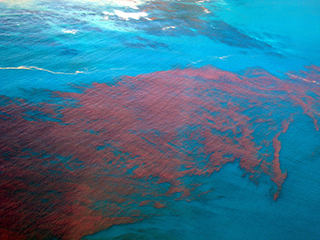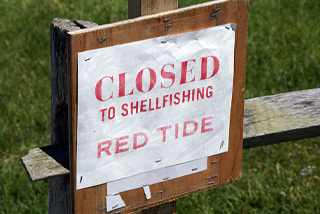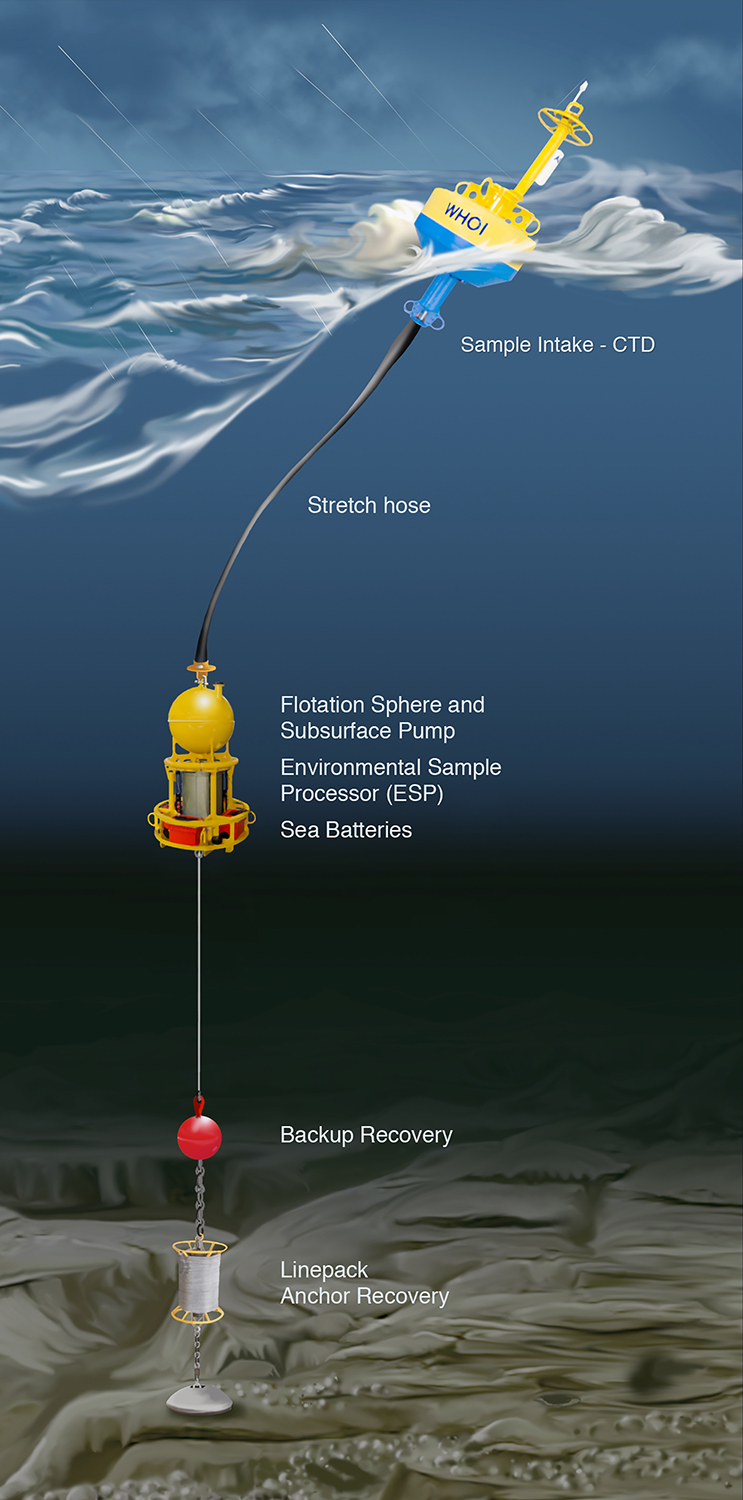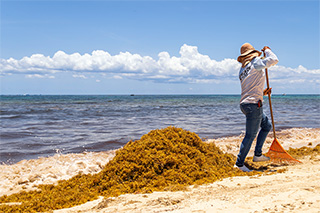Introduction

What are algae?
Algae are microscopic organisms that live in aquatic environments and use photosynthesis to produce energy from sunlight, just like plants. Algae can be found in all types of natural waters, including salt water, fresh water, and brackish water (a mix of salt and fresh water).
A few types of algae produce toxins. In these algae, toxin production can be stimulated by environmental factors such as light, temperature, salinity, pH, and nutrient levels. Algal toxins released into the surrounding water or air can seriously harm people, animals, fish, and other parts of the ecosystem.
What is a harmful algal bloom?
A harmful algal bloom (HAB) occurs when toxin-producing algae grow excessively in a body of water. The excessive algal growth, or algal bloom, becomes visible to the naked eye and can be green, blue-green, red, or brown, depending on the type of algae.
Some blooms are easy to spot, but others are hard to see because they grow near the bottom of water bodies. You cannot tell if a water body has a harmful bloom just by looking at it.
Why do HABs occur?
Many factors may contribute to HABs but understanding how these factors come together to create a harmful bloom of algae is a topic of ongoing research. Scientists know that certain environmental conditions, such as warmer water temperatures in the summer and excessive nutrients from fertilizers or sewage waste brought by runoff, trigger HABs, but they are still learning more.
What are impacts from HABs?
HABs can damage the environment by depleting oxygen in the water, which can kill fish and other living creatures. HABs that bloom near the water surface can also block sunlight from reaching organisms deeper in the water.
The economic impacts of HABs to fisheries and recreational areas can be extensive. Businesses lose significant revenue if they are forced to close or reduce operations due to HABs.
Some HABs are associated with serious health effects, as explained below.
How are people exposed?

During an HAB, people can get exposed to toxins from fish they catch and eat, from swimming in or drinking the water, and from the air they breathe. In recent years, there have been numerous instances of HABs in lakes that provide drinking water, like Lake Erie. Importantly, cooking contaminated seafood or boiling contaminated water does not destroy the toxins. NIEHS research has helped us better understand how toxins accumulate in seafood and are later absorbed by our bodies.
People can get sick from eating seafood contaminated with HAB-related toxins. But it rarely happens from eating commercial seafood because state regulators monitor fisheries for HABs and close them during blooms.
Illness from HABs can be prevented by following local health advisories on the safety of recreationally caught seafood and drinking water sources.
What are the health effects of harmful algal blooms?
Depending on the type of algae, HABs can cause serious health effects and even death. For example, eating seafood contaminated by toxins from algae called Alexandrium can lead to paralytic shellfish poisoning, which can cause paralysis and even death. The algae Pseudo-nitzschia produces a toxin called domoic acid that can cause vomiting, diarrhea, confusion, seizures, permanent short term memory loss, or death, when consumed at high levels.
HABs that occur in freshwater, like the Great Lakes and other drinking water sources, are dominated by the cyanobacteria Microcystis. This organism produces a liver toxin that can cause gastrointestinal illness as well as liver damage.
As with many environmental exposures, children and the elderly may be especially sensitive to HAB toxins. Populations that rely heavily on seafood are also at risk of long-term health effects from potentially frequent, low-level exposures to HAB toxins.
The table below summarizes common HABs and their health effects.
| Organism | Water Type | Color | Toxin | Health effects |
|---|---|---|---|---|
| Alexandrium sp. | Salt | Red or brown | Saxitoxins | Gastrointestinal (nausea, vomiting), and neurological (a floating sensation, headache, or muscle weakness) |
| Cyanobacteria | Fresh | Blue-green | Cylindrospermopsin | Nausea, vomiting, diarrhea, abdominal tenderness, pain, or acute liver failure |
| Gambierdiscus | Salt | Orange | Ciguatoxins | Nausea, vomiting, diarrhea, or stomach pain |
| Karenia brevis | Salt | Red | Brevetoxins |
|
| Pseudo-nitzschia | Salt | Red or brown | Domoic acid | Vomiting, head weaving, nausea, seizures, diarrhea and abdominal cramps, bulging eyes, or headache |
| Microcystis | Fresh | Blue-green | Microcystin | Gastrointestinal illness, liver damage |
What is NIEHS Doing?

NIEHS and the National Science Foundation jointly fund research on marine-related health issues through the Centers for Oceans and Human Health. Researchers are developing techniques for improved detection of HABs to prevent and reduce exposure. They also study longer-term health effects, such as neurological conditions, from HAB toxins.
Improving prediction
Improved monitoring and prediction of HABs enables public officials to be one step ahead of blooms. Better global data sets will enable scientists to answer questions on the relationships between HABs and climate, contamination from agricultural runoff, and aquaculture and to predict trends.
NIEHS-funded researchers from the Woods Hole Center for Oceans and Human Health found that in deep waters, the algae Alexandrium fundyense may bloom based on an internal annual clock, while in shallow waters, conditions such as temperature may trigger blooms. These researchers have also shown that the number of dormant algae that remain after a summer bloom of Alexandrium fundyense can be used to predict the extent of the next year’s bloom.
A study of New England and Canadian coastal waters points to large-scale water movements and salinity as key factors in predicting algal blooms.
Over several years of study, Ohio-based researchers developed a framework with lake-specific criteria for annually determining if a waterbody is impaired by toxic cyanobacteria HABs, which are a significant threat to the security of freshwaters.
Guanitoxin, a naturally occurring and lethal cyanotoxin, can cause HABs in lakes and can affect people’s nervous system. Currently, it is not environmentally monitored because chemical instability causes it to degrade quickly, making it difficult to detect using standard methods. But detection may become possible because scientists have uncovered guanitoxin’s genetic composition, allowing some monitoring to establish its global scope.
Research on algae-related toxins
Microcystin: This toxin, commonly released during harmful algal blooms, can change the gut’s collection of microorganisms, also called the microbiome, and the associated abundance of antibiotic resistance genes, according to a NIEHS-funded study in mice. Another NIEHS-funded study suggests that microcystin may act in conjunction with poor diet and lifestyle stressors to contribute to the development of a form of liver cancer.
Cyanotoxins: NIEHS-funded scientists also linked exposure to cyanotoxins—toxins released during cyanobacterial algal blooms—with liver injury and the development of liver cancer.
NIEHS-funded researchers used animal models to see how cyanobacterial HABs may affect women’s reproductive health. They found that environmental exposure to these toxins interfered with gonadotropin-dependent follicle maturation and ovulation. This interference could increase the chance of irregular menstrual cycles and infertility related to ovulatory disorders.
Brevetoxins: Exposure to toxins released during Karenia brevis blooms in southwest Florida seawater was linked with neurotoxic shellfish poisoning and upper respiratory symptoms.
Health effects over time
While immediate health effects of harmful algal blooms are known, the long-term health effects in people and animals remain unclear. Scientists are now investigating potential long-term or chronic health effects of HABs. For example, NIEHS-funded researchers are studying whether consuming trace amounts of neurotoxic domoic acid over time damages brain function, especially among children or the elderly. Domoic acid is a neurotoxin produced by certain harmful algae. In animals, scientists have observed that chronic, low-level exposure altered the expression of genes controlling the nervous system and impaired cell function.
Other NIEHS-supported research
Several studies by NIEHS-funded researchers explored the causes of HABs in the western portion of Lake Erie, especially in bays and estuaries where toxin concentrations often exceed EPA advisory levels. Research also demonstrates the importance of controlling the introduction of nitrogen and phosphorus into the watershed to combat cyanotoxin and cyanobacterial production.

Sargassum is a type of brown macroalgae that floats in island-like masses, sometimes stretching for miles across the ocean. Unlike red and blue-green algae, Sargassum is not generally considered harmful. A floating mass of Sargassum can provide habitat for an array of marine life.
But too much of it may lead to harmful effects on ecosystems, which leads scientists to study how to deal with it. They are beginning to identify the nutrients that might be helping it thrive.
While conducting research on the composition of Sargassum, researchers found that caution is needed when humans handle it. Sargassum inundating shores near the Great Atlantic Sargassum Belt, especially Caribbean and Florida coastlines, may contain unsafe arsenic concentrations. This finding has implications for Sargassum management.
Educational partnerships
Shellfish toxins are a problem for Alaskan residents who rely on this food source. NIEHS has partnered with Southeast Alaska Tribes and local universities to promote the safe consumption of shellfish. The Sitka Tribe of Alaska Environmental Research Lab, part of the Southeast Alaska Tribal Ocean Research network, conducts research to identify safe harvest times for shellfish. If shellfish have unsafe levels of toxins, the Sitka Tribe sends out a community-wide alert.
A program developed at Savannah State University and affiliated with the Woods Hole Oceanographic Institution, teaches middle school students to use real data to track harmful algal blooms. In doing so, students learn the importance of HABs and how they relate to oceans and human health. The lessons use an open-source data portal, the WHOI HAB Hub, for tracking different species of HABs over time.
Further Reading
Stories from the Environmental Factor (NIEHS Newsletter)
- New Film Series Educates Community About Harmful Algal Blooms (August 2024)
- Algal Toxin May Harm Women’s Reproductive Health (September 2023)
- Disinfectant Reduces Toxic Byproduct Levels in Algae-affected Water (July 2023)
- Exposure to Harmful Algal Bloom Toxin Alters Gut Microbiome, Antibiotic Resistance (September 2022)
- Harmful Algal Bloom Predictions Can Advance With Genetic Findings (June 2022)
- Harmful Algal Blooms Challenge Ecosystems, Food Security (November 2021)
Additional Resources
- CDC - One Health Harmful Algal Bloom System - This reporting system collects information to aid understanding of HABs and help prevent human and animal illnesses caused by them.
- Marine harmful algal blooms in the United States – This 2021 open-access research paper presents the history, current status, and future trends of HABs.
- National Oceanic and Atmospheric Administration - These webpages of the NOAA National Ocean Service provide resources related to harmful algal blooms. This office also studies HABs and provides regional forecasts.
- National Office for Harmful Algal Blooms - This federally funded organization has a clearinghouse for information related to national and international HAB issues.
- Southeast Alaska Tribal Ocean Research resources include a video about shellfish testing and downloadable briefing sheets on shellfish and HABs.
- Staying Safe in the Water - This 2022 story from “NIH News in Health” offers tips for pool, lake, or beach recreation, including guarding against HABs in natural waters.
Related Health Topics
This content is available to use on your website.
Please visit NIEHS Syndication to get started.

